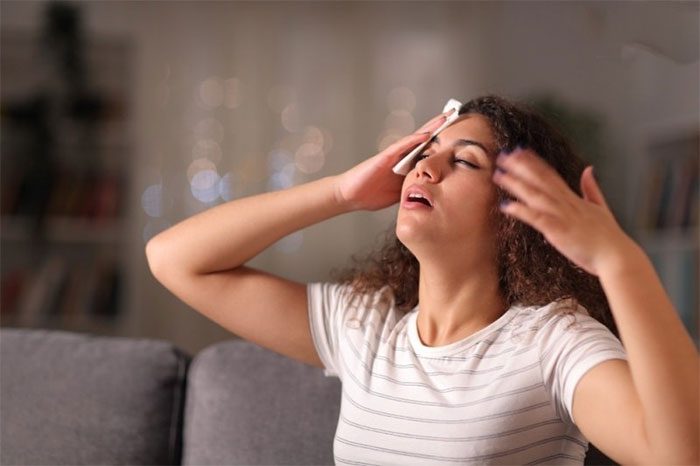The body not sweating can be caused by a condition known as anhidrosis. Prolonged inability to dissipate heat, leading to the body not cooling itself, can result in serious complications related to temperature, such as heat stroke, muscle cramps, or exhaustion.
What is Anhidrosis?
1. Overview
Anhidrosis is another term for the condition where the body does not sweat as it normally should, which prevents the body from cooling itself, leading to overheating, and sometimes resulting in heat stroke or even death.
There are many factors that can cause anhidrosis, including skin injuries, certain diseases, and medications.
Treatment for the body not sweating due to anhidrosis can be highly effective when the underlying cause is identified.
2. Symptoms
Signs and symptoms of anhidrosis include:
- Little or no sweating
- Dizziness
- Muscle cramps or weakness
- Flushing
- Feeling hot
The condition of not dissipating heat can occur over most areas of the skin or in a specific area of the body.
When one area cannot dissipate heat, the body compensates by increasing heat dissipation in other areas. Anhidrosis impedes the body’s ability to cool itself, so individuals with anhidrosis should limit high-intensity exercise, heavy work, and exposure to direct sunlight to avoid the risk of cramps, heat exhaustion, or even heat stroke.
Anhidrosis can be a primary condition or a symptom of another disorder such as diabetes or skin injury.
If the body is almost not sweating in hot weather, during work, or high-intensity exercise, it is important to see a doctor for early diagnosis and treatment.

Symptoms of anhidrosis with dizziness.
3. Causes
Anhidrosis can be a congenital condition or due to diseases affecting the nerves and skin, or due to dehydration. Occasionally, the cause of anhidrosis cannot be determined.
The main causes of anhidrosis include:
- Inherent conditions, such as certain congenital dysplasias affecting sweat gland development
- Genetic conditions affecting metabolic systems, such as Fabry disease
- Connective tissue diseases such as Sjögren’s syndrome, which causes dry eyes and mouth
- Skin damage from burns, radiation, or diseases that block sweat glands, such as psoriasis
- Nerve damage caused by diabetes, alcoholism, and Guillain-Barre syndrome
- Medications such as morphine and botulinum toxin type A, as well as those used to treat psychiatric disorders
4. Complications
Heat-related illnesses are the most serious complications of anhidrosis. Children are particularly vulnerable because their body temperature rises more quickly than that of adults, and their bodies dissipate heat less effectively.
The inability to self-regulate temperature can lead to various complications for the body, especially in children, as their temperature rises more quickly and dissipates heat more slowly than adults. Common complications of anhidrosis include:
- Heat cramps: Symptoms include pain or muscle cramps. If you experience this condition, you should rest in a cool place and drink more water. If cramps persist for more than one hour, seek medical attention immediately.
- Exhaustion: Symptoms include weakness, nausea, and rapid heartbeat. In this situation, the patient should be moved to a cool place and emergency services should be called if symptoms last more than one hour.
- Heat stroke: Heat stroke occurs when body temperature rises to 39.5 degrees Celsius or higher, causing red, hot, or dry skin. If not treated immediately, heat stroke can lead to unconsciousness.
5. Prevention
Anhidrosis is often not preventable, but its serious complications can be. Therefore, you should pay attention to:
- Wear loose, thin clothing in warm weather.
- Stay indoors in a cool environment on hot days.
- Use a spray bottle with water to cool the body.
- Monitor your activity levels closely to avoid overexertion that could lead to overheating.
- Learn the signs of heat-related illnesses and how to treat them.
The body’s inability to sweat can have serious health implications for the affected individuals. Therefore, consider the factors and take preventive measures to avoid dangerous complications.


















































